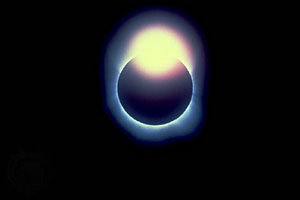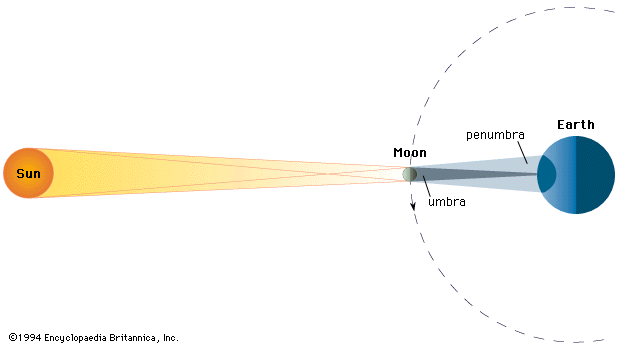
Solar eclipse, Java, June 11, 1983, showing the diamond ring effect. This effect occurs when only the barest sliver of the Sun is visible around the Moon during a total solar eclipse.
An eclipse is the complete or partial obscuring of a celestial body by another other. An eclipse occurs when three celestial objects become aligned.
The many eclipse phenomena known to astronomers are of two distinctly different types. In the first, the eclipsing body comes between an observer and the eclipsed object; the latter appears to the observer totally or partly covered by the eclipsing object. Eclipses of the Sun, occultations of stars by the Moon, transits of Venus or Mercury across the Sun's disk, and eclipses of binary stars are of this kind. Eclipses of the second type affect only planets or natural satellites that are not self-luminous. In this case, the eclipsing body intervenes between the Sun and the eclipsed object. The latter remains in view of the observer, but its illumination by the Sun is interrupted, and it becomes darkened by entering into the shadow of the eclipsing object. Examples of this kind of eclipse phenomenon are eclipses of the Moon.
Solar and lunar eclipses have long been of interest, because they are readily observable to the unaided eye and offer an impressive spectacle. Primitive peoples were struck with fear by the falling darkness during a total solar eclipse or by the strange sight of the eclipsed Moon. Accounts of such eclipses are found among the oldest records of history, and the successful prediction of eclipses constitutes one of the earliest achievements of the scientific investigation of nature.

Solar eclipse, Java, June 11, 1983, showing the diamond ring effect. This effect occurs when only the barest sliver of the Sun is visible around the Moon during a total solar eclipse.
A solar eclipse occurs when the Moon, revolving in its orbit around the Earth, moves across the disk of the Sun so that the shadow of the Moon sweeps over the face of the Earth. No sunlight penetrates the umbra, the inner part of the shadow. To observers on the Earth within the umbra, the disk of the Sun will appear completely covered by that of the Moon. Such a solar eclipse is said to be total. Because the umbra is narrow at its intersection with the Earth, a total eclipse can be observed only within a very narrow area--the zone of totality. Furthermore, because of the relative motion of the bodies, the conical shadow moves rapidly over the terrestrial surface; the totality of the solar eclipse thus lasts only a short time (less than eight minutes at any one place on the Earth). To observers located within the penumbra, the outer portion of the Moon's shadow, the disk of the Moon will appear to be projected against the Sun so as to overlap it in part. This gives rise to a partial solar eclipse. Because the Earth revolves around the Sun in an elliptical orbit, the distance of the Sun changes slightly during the course of a year. Similarly, the apparent size of the lunar disk changes to some degree during a month because of the elliptical shape of the Moon's orbit. If an eclipse occurs when the Sun is closest to the Earth and the Moon is farthest away, the Moon will not completely cover the Sun, thereby leaving the rim of the latter all around it. This form of eclipse is known as an annular eclipse.

The shadow of the Moon sweeps over the surface of the Earth. In the darkly shaded region (umbra) the eclipse is total; in the lightly shaded region (penumbra) the eclipse is partial. The shaded region on the opposite side of the Earth indicates the darkness of night. (Dimensions of bodies and distances are not to scale.)
Partial solar eclipses yield little information of astronomical interest. Total eclipses, on the other hand, have contributed much knowledge about the nature of the chromosphere and corona, the thin external layers of the Sun that are usually lost in the brilliant glare from the shining solar surface (the photosphere). At total eclipse the Moon acts as a screen outside the Earth's atmosphere, cutting off the direct rays from the photosphere. The brillance of the sky is decreased greatly, and the fainter appendages of the Sun become visible. The astronomical value of eclipse observation has decreased in recent years, largely as a result of the invention of the coronagraph. This instrument obscures the photosphere artificially and thereby makes it possible for investigators to conduct studies of the solar chromosphere and corona without waiting for eclipses to occur.

Total solar eclipse. The delicately structured glow of the solar corona--or solar atmosphere--seen during the March 7, 1970, total eclipse of the Sun. The corona is visible to the unaided eye only during an eclipse.
A lunar eclipse occurs when the Moon travels through the shadow of the Earth and loses its bright illumination by the Sun. It can occur only at the time of the full Moon (i.e., when the Moon is directly opposite the Sun), because the Earth's shadow is directed away from the Sun. A lunar eclipse can be seen from any place on the Earth where the Moon is above the horizon. Such an eclipse can be total, partial, or penumbral, depending on the Moon's position. If the Moon passes through the center of the Earth's umbra, a total lunar eclipse occurs. Totality may extend up to 100 minutes, with the entire eclipse lasting about 3 1/2 hours. A partial lunar eclipse is observable when only a part of the Moon passes through the umbra. The penumbral variety occurs when the Moon moves solely through the outer part of the shadow. Lunar eclipses generally occur twice a year. In some years, however, there may be none, whereas in others, one or possibly three may take place.

The Moon revolving in its orbit around the Earth passes through the shadow of the Earth. Umbra is the total shadow,penumbra the partial shadow.
Lunar eclipses are of limited value for astronomical research. They have enabled scientists to study the reactions of materials on the Moon's surface to the sudden removal of solar radiation. The results of this research have led to a better understanding of the structure and heat conductivity of lunar soil.
From the Earth, the Moon appears against a background of distant stars. As the Moon moves eastward across the constellations, it occasionally passes in front of one of the brighter stars or a planet, causing an occultation. At the moment when the eastern limb of the Moon reaches a star, the latter suddenly disappears (immersion). In about an hour or less, the Moon will have passed over the star and the star will reappear at the western limb (emersion). Accurately timed observations of occultations are used to study the orbital motion of the Moon. Measurements of the time required for a star to disappear also provide information about the diameters of the stars.
The two planets Mercury and Venus, which are closer to the Sun than is the Earth, occasionally pass between the Earth and the Sun. At such a time, either of these planets appears as a small, dark circular disk projected on the brilliant disk of the Sun, crossing it slowly. Transits of Venus have been of considerable importance for accurately determining the solar parallax.
Eclipsing binaries are double-star systems consisting of two stellar bodies that revolve around one another in an orbit whose plane nearly passes through the solar system. Thus, one star passes periodically in front of or behind the other as seen from the Earth, and two eclipses take place during each revolution. From the way in which the light from the binary system varies, it is possible to calculate the orbit and relative sizes of the two components.
Excerpt from the Encyclopedia Britannica without permission.